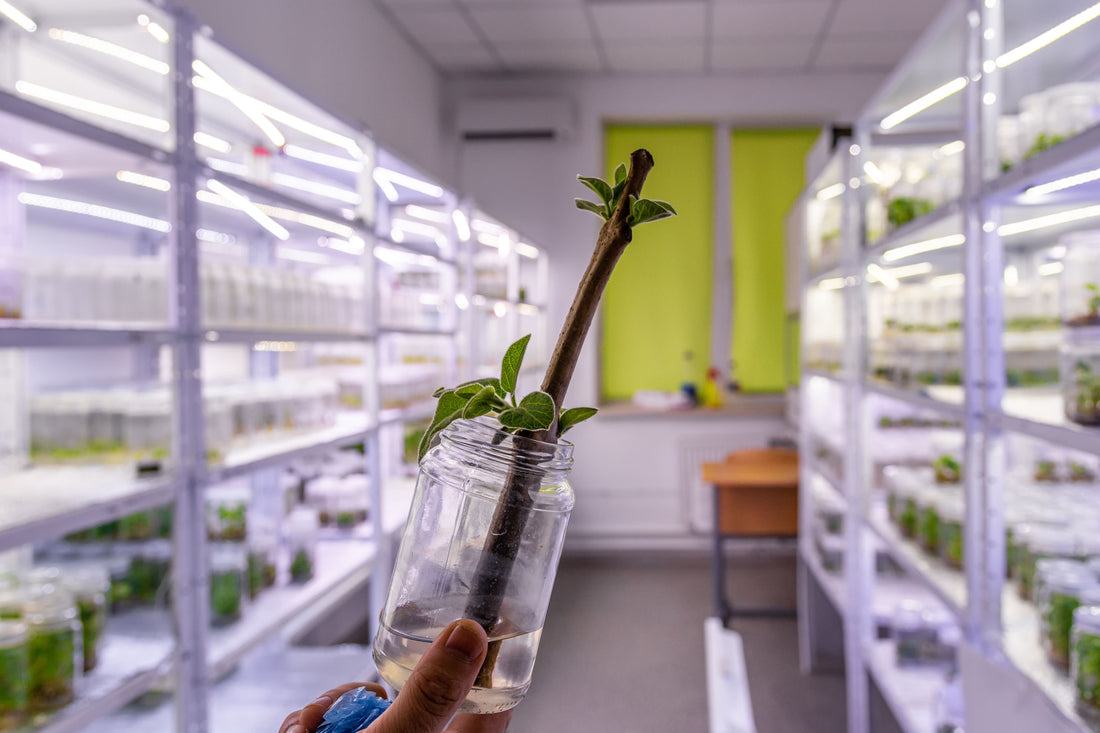
Application and Limitation of Micropropagation
As a content and community manager, I leverage my expertise in plant biotechnology, passion for tissue culture, and writing skills to create compelling articles, simplifying intricate scientific concepts, and address your inquiries. As a dedicated science communicator, I strive to spark curiosity and foster a love for science in my audience.


Micropropagation is the rapid multiplication of plants at a large scale under artificial conditions. It follows asexual means of reproduction (through vegetative parts of the plants). In the clonal propagation of plants, genetically identical plants are produced by multiplying an individual plant with desired characters under suitable growth conditions. The process involves five stages:
- Stage 0: Selection of source or elite plants
- Stage I: Establishment of cultures
- Stage II: Multiplication of the regenerated shoots
- Stage III: Rooting of shoots and germination of somatic embryos
- Stage IV: Transfer to soil and acclimatization
The two approaches involved in the clonal propagation under artificial conditions are multiplication by shoots/apical shoots and multiplication by adventitious shoots. In the previous articles of the micropropagation series, you must have learned about what is micropropagation, what are the stages involved in the process of propagation, and what are the ways or methods of micropropagation. So, in continuation with the series, this article presents the application/advantages, and disadvantages/limitations of micropropagation.
Factors Impacting Micropropagation
- The genotype of the plants
- Physiological status of the plants
- Culture media
- Culture environment
Application/Advantages of Micropropagation
- Micropropagation is the best technique for the production of millions of clones in one year. When it comes to conventional techniques, it takes years to produce an equal number of plants.
- Micropropagation facilitates the growth, storage, and maintenance of a large number of plants in small spaces which makes it a cost-effective process.
- Micropropagation is used for germplasm storage and the protection of endangered species. Seeds and vegetative organs of several species of plants have a limited storage life. Meristem cells are used for this purpose because they are stable, survive under cryopreservation procedures, and regenerate into pathogen-free plants whenever required.
- Some plants are difficult or resistant to be grown on a large scale by conventional techniques. Micropropagation is a good alternative to cultivate these plants.
- Micropropagation can be used to obtain disease or pathogen-free plants. Meristem tip culture is used to achieve this goal. For example, virus-free potatoes can only be obtained by the micropropagation of plants.
- The micropropagation technique is the best alternative for clonal propagation at a large scale in a very short time. At times, the use of this technique has proven to reduce the time to culture by 50 %.
- Micropropagation is used to increase the vigor and yield of floriculture species by multifold.
- Micropropagation is popular for the production of synthetic seeds that analog to true seeds. These seeds match with the morphology, physiology, and biochemistry of the zygotic embryos.
- Micropropagation also allows the production and regeneration of the stored stocks all over the year. It's best for nurseries that are willing to sell fruit, ornamental plants, and tree species any time of the year.
- Micropropagation is the best technique to transfer different species of plants to different countries. This makes the international exchange processes easier and reduces the risk of contamination during the transfer.
Disadvantages of Micropropagation
- Micropropagation requires trained manpower, sophisticated facilities, and expensive materials which make it a pricey technique.
- Contamination is the major problem of micropropagation. The cultures grown in labs are very sensitive to any microorganisms. The source can be water, media, chemical components you use for your cultures, air, or even your hands. The most dangerous contaminant is mycoplasma that lives inside the cell. You need a high power microscope to observe them in your tissue culture explants. The culturists try to prevent these using antibodies or fungicides but they can disturb the genetic makeup of the explant.
- Some forms of cultures have the problem of pronounced genetic variability. When the plants are propagated through shoot tip cultures, the genetic variability is low, but pronounced, Genetic variability is observed when they are grown using adventitious shoots. The genetic variability can be due to aberrant cell division in the callus, chimeral breakdown, or pre-existing genetic variability.
- Some plants are difficult to maintain by micropropagation because they start releasing growth inhibitory substances (like phenol) in the medium. These compounds turn the medium into dark color (it’s called brewing of the medium) and inhibit the growth of the tissues.
- When cultures undergo repeated cycles of in vitro shoot multiplication, they develop water-soaked, translucent leaves.
- Intensive in vitro shoot multiplication by micropropagation causes vitrification which is also known as hyperhydration. This phenomenon can be reduced by the methods explained below:
- Increase the concentration of the agar
- Overlay medium with paraffin
- Use desiccant such as copper sulfate.
- Cool the bottom of the culture vessel to allow aeration.
- Lower the cytokinin concentration or replace one cytokinin with another.
- Alter NH+ or salt concentration in the culture medium.
References
- Bhatia, S., & Sharma, K. (2015). Micropropagation. Modern Applications of Plant Biotechnology in Pharmaceutical Sciences, 361–368. doi:10.1016/b978-0-12-802221-4.00011-x
- https://microbenotes.com/micropropagation-stages-types-applications-advantages-limitations/
- https://www.biologydiscussion.com/biotechnology/clonal-propagation/micro-propagation-technique-factors-applications-and-disadvantages/10732
- https://www.onlinebiologynotes.com/micropropagatio...
Blog Categories
View by Level
Popular Blogs

Callus Culture: Definition and Applications
Introduction Tissue culture is not just one technique! Yes, you heard right! As you know, tissue culture is an advanced...
Read More
6 Plant Tissue Culture Books to Keep Learning
Introduction Most of us are fans of books when it comes to learning a topic in detail and in a...
Read MoreSubscribe to Our Newsletter








Join the conversation
Your email address will not be published. Required fields are marked